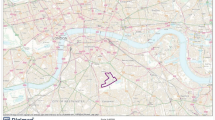Abstract
Arthur Ussher, owner of the Ballysaggartmore estate in west County Waterford in the early 1800s, was one among many notorious landlords in Ireland during the Great Famine of 1847–52. He is remembered to this day in the locality for evicting hungry tenants and demolishing their houses for the non-payment of rents on his small estate, having earlier secured some improvement of land-quality through their labor. Buildings and designed-landscape features of Ussher’s demesne remain today, and are capable of an archaeological reading. They speak eloquently, even spectacularly, of the self-aggrandizing values of his social class. Relatively little “tenant archaeology” survives above-ground on the former estate, and most of the sites of eviction before and during the Famine are unidentified, but the story of their removal, and of tenant resistance—or non-resistance, more accurately—to it, is of some interest to students of the historical archaeology of the period. This paper documents the rise and fall of the Ussher project, illuminating the social violence that was often unleashed from landlord culture through the agency of Improvement.












Similar content being viewed by others
References
Anonymous (1912). Parochial history of Waterford and Lismore, N. Harvey, Waterford.
Ball Wright, W. (1889). The Ussher Memoirs, or, Genealogical Memoirs of the Ussher Families in Ireland. Sealy, Bryers, and Walker, London.
Barnard, T. (2008). Improving Ireland? Projectors, Prophets, and Profiteers, Four Courts Press, Dublin.
Beames, M. R. (1978). Rural conflict in pre-famine Ireland: peasant assassinations in Tipperary 1837–1847. Past and Present 81: 75–91.
Bence-Jones, M. (1978). Burke’s Guide to Country Houses: Ireland, Burke’s Peerage, London.
Busteed, M. (2000). The practice of improvement in the Irish context: the Castle Caldwell estate in county Fermanagh in the second half of the eighteenth century. Irish Geography 33: 15–36.
Butler, D. J. (2012). The landed classes during the great famine. In Crowley, J., Smyth, W. J., and Murphy, M. (eds.), Atlas of the Great Irish Famine, Cork University Press, Cork, pp. 265–276.
Carroll, M. P. (1999). Irish Pilgrimage: Holy Wells and Popular Catholic Devotion, Johns Hopkins University Press, Baltimore.
Clark, S., and Donnelly, J. S. (eds.) (2003). Irish Peasants: Violence and Political Unrest, 1780–1914, University of Wisconsin Press, Madison.
Commissioners for Encumbered Estates. (1854). National Archives of Ireland, Dublin.
Conant, K. J. (1968). The after-life of Vitruvius in the middle ages. Journal of the Society of Architectural Historians 27: 33–38.
Connolly, S. (1982). Priests and People in Pre-Famine Ireland 1780–1845, Gill and Macmillan, Dublin.
Connolly, S. (1995). Religion, Law, and Power: The Making of Protestant Ireland, 1660–1760, Oxford University Press, Oxford.
Cork Examiner, The (1847). May 5.
Cowman, D., and Brady, D. (eds.) (1995). The Famine in Waterford, 1845–1850, Geography Publications, Dublin.
Dickson, D. (1979). Middlemen. In Bartlett, T., and Hayden, D. W. (eds.), Penal and Golden Age: Essays in Irish History, 1690–1800, Queens University Belfast Institute of Irish Studies, Belfast, pp. 162–185.
Donnelly, J. S. (2009). Captain Rock: The Irish Agrarian Rebellion of 1821–1824, University of Wisconsin Press, Madison.
Dooley, T. (2001). The Decline of the Big House in Ireland: A Study of Irish Landed Families, 1860–1960, Wolfhound Press, Dublin.
Feeney, P. (1984). Ballysaggart Estate: eviction, famine and conspiracy. Decies 27: 5–12.
Girouard, M. (1964). Lismore Castle, Co. Waterford (part 1). Country Life August 6, ppp. 336–340.
Guinnane, T. W., and Miller, R. I. (1997). The limits to land reform: the Land Acts in Ireland, 1870–1909. Economic Development and Cultural Change 45: 591–612.
Heffernan, K., and Villensteiner, F. (1999). The History of Strancally Castle and Valley of the Blackwater Between Lismore and Youghal, Strancally Castle Library, Knockanore.
Howley, J. (1993). The Follies and Garden Buildings of Ireland, Yale University Press, New Haven.
James, D. (1998). John Hamilton of Donegal 1800–1884: This Recklessly Generous Landlord, Woodfield Press, Dublin.
Kearney, H. F. (1953). Richard Boyle, ironmaster: a footnote to Irish economic history. Journal of the Royal Society of Antiquaries of Ireland 83(2): 156–162.
O’Keeffe, T. (2013). Lohort Castle: medieval architecture, medievalist imagination. Journal of the Cork Historical and Archaeological Society 118: 60–70.
O’Keeffe, T., and Quirke, S. (2009). A house at the birth of modernity: Ightermurragh Castle, Co. Cork. In Lyttleton, J., and Rynne, C. (eds.), Plantation Ireland, Four Courts Press, Dublin, pp. 86–112.
Orser Jr., C. E. (2005). Symbolic violence, resistance and the vectors of improvement in early nineteenth-century Ireland. World Archaeology 37: 392–407.
Orser Jr., C. E. (ed.) (2006). Unearthing Hidden Ireland: Historical Archaeology in County Roscommon, Wordwell Press, Bray.
Orser Jr., C. E. (2012). Ballykilcline. In Crowley, J., Smyth, W. J., and Murphy, M. (eds.), Atlas of the Great Irish Famine, Cork University Press, Cork, pp. 318–323.
O’Sullivan, N. (2004). Imaging the land war. Éire-Ireland 39(3&4): 100–131.
Pakenham, V. (2000). The Big House in Ireland, Cassell, London.
Pender, S. (1939). Census of Ireland circa 1659 with Supplementary Material from the Poll Money Ordinances (1660–1661), Stationery Office, Dublin.
Royal Commission. (1845). Royal Commission . . . in Respect to the Occupation of Land in Ireland (1845), State of the Law and Practice in Respect to the Occupation of Land in Ireland: Evidence taken before Her Majesty's Commissioners: Part II. Her Majesty’s Stationery Office, London.
Tarlow, S. (2007). The Archaeology of Improvement in Britain, 1750–1850, Cambridge University Press, Cambridge.
Whelan, D. (2010) An Historical Archaeology of Rural Landscape, Settlement and Society in West Waterford and East Cork, AD 1600–1900. Doctoral dissertation, University College Dublin, Dublin.
Author information
Authors and Affiliations
Corresponding author
Rights and permissions
About this article
Cite this article
Whelan, D.A., O’Keeffe, T. The House of Ussher: Histories and Heritages of Improvement, Conspicuous Consumption, and Eviction on an Early Nineteenth-Century Irish Estate. Int J Histor Archaeol 18, 700–725 (2014). https://doi.org/10.1007/s10761-014-0276-z
Published:
Issue Date:
DOI: https://doi.org/10.1007/s10761-014-0276-z




